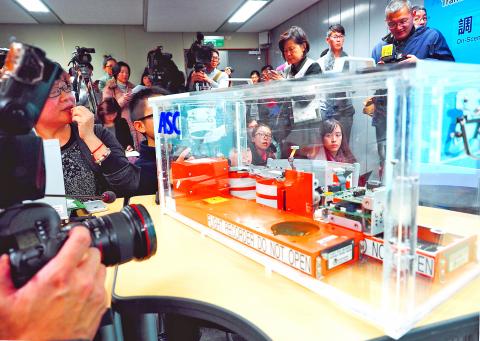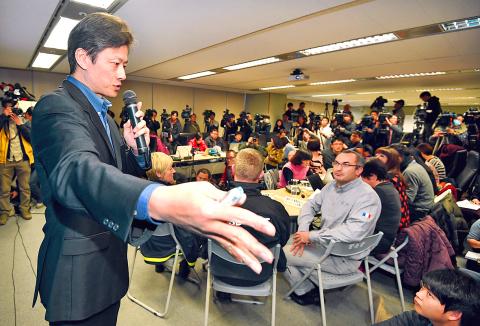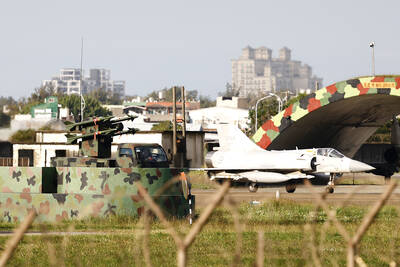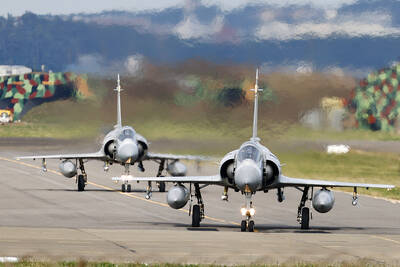The Aviation Safety Council yesterday revealed preliminary information from the flight data recorder (FDR) and cockpit voice recorder of the crashed TransAsia Airways Flight GE235, showing that the pilots may have mistakenly turned off the engine that could have kept it airborne.
Council executive director Thomas Wang (王興中) said that the master warning for the No. 2 engine was triggered about 37 seconds after takeoff, which indicated that the engine had flamed out. During that time, the airplane was flying at an altitude of 457m, he said.
Wang also said that the propellers of the No. 2 engine went into the feathered mode after the flame-out signal. The auto-feather system is activated when the power of the engine becomes insufficient to produce the thrust, he said, adding that the system helps reduce drag during an engine failure.

Photo: EPA
“Even though the flame-out alarm went off, the engine did not actually flame out and was still running,” Wang said, adding that the aircraft’s dashboard should have informed the pilot that it was the No. 2 engine that had malfunctioned.
Despite the problem with the No. 2 engine, Wang said that the flight crew did not shut it down, but decided to increase its throttle.
Wang said that although there was no sign of abnormality with the No. 1 engine, the flight crew manually turned it off when the airplane climbed to 488m, leading that engine to go into feathered mode as well.

Photo: Liao Chen-hui, Taipei Times
The flight crew later tried to restart the No. 1 engine, but did not have enough time to power the engine back into full operation, Wang said.
The data further showed that the aircraft had sounded a stall warning five times before the FDR stopped recording.
After the third stall warning, the flight crew contacted the control tower and called out: “Mayday, Mayday, engine flame-out.”
The council also showed the data plot from the FDR of the engines, which indicated that both engines had operated normally before the No. 2 engine went into feathered mode.
As to what led to the failure of the No. 2 engine and why the flight crew decided to turn off the No. 1 engine following a brief discussion, Wang said that these questions could only be answered after further investigation.
Previously, media reports had speculated that the problem could be with the No. 1 engine, as the company had replaced it twice since it acquired the aircraft from the French manufacturer.
Yann Torres, a representative from the French Bureau of Enquiry and Analysis for Civil Aviation, also attended the press conference and confirmed that the ATR 72-600 airplanes are able to operate with one engine, even during take-off.
Meanwhile, the Civil Aeronautics Administration (CAA) said that all pilots operating ATR 72 models are to be retrained.
Clark Lin (林俊良), director of the administration’s flight standards division, said that the airline has 71 pilots trained to fly ATR 72 planes, adding that they would be required to take an oral test on operating the aircraft.
The test would be administered over four days, beginning today, he said.
Lin said that pilots could still fly the airplanes before they take the test, because they are qualified pilots.
However, they must finish the test within four days and would be asked to be requalified as pilots if they fail the test, Lin said.
The pilots would later be asked to operate a flight simulator as well.
CAA statistics showed that of five TransAsia Airways incidents between 2010 and last year that involved problems with an engine, two of them were attributed to human error.

Taiwan is gearing up to celebrate the New Year at events across the country, headlined by the annual countdown and Taipei 101 fireworks display at midnight. Many of the events are to be livesteamed online. See below for lineups and links: Taipei Taipei’s New Year’s Party 2026 is to begin at 7pm and run until 1am, with the theme “Sailing to the Future.” South Korean girl group KARA is headlining the concert at Taipei City Hall Plaza, with additional performances by Amber An (安心亞), Nick Chou (周湯豪), hip-hop trio Nine One One (玖壹壹), Bii (畢書盡), girl group Genblue (幻藍小熊) and more. The festivities are to

Auckland rang in 2026 with a downtown fireworks display launched from New Zealand’s tallest structure, Sky Tower, making it the first major city to greet the new year at a celebration dampened by rain, while crowds in Taipei braved the elements to watch Taipei 101’s display. South Pacific countries are the first to bid farewell to 2025. Clocks struck midnight in Auckland, with a population of 1.7 million, 18 hours before the famous ball was to drop in New York’s Times Square. The five-minute display involved 3,500 fireworks launched from the 240m Sky Tower. Smaller community events were canceled across New Zealand’s

‘IRRESPONSIBLE’: Beijing’s constant disruption of the ‘status quo’ in the Taiwan Strait has damaged peace, stability and security in the Indo-Pacific region, MOFA said The Presidential Office yesterday condemned China’s launch of another military drill around Taiwan, saying such actions are a “unilateral provocation” that destabilizes regional peace and stability. China should immediately stop the irresponsible and provocative actions, Presidential Office spokeswoman Karen Kuo (郭雅慧) said, after the Chinese People’s Liberation Army (PLA) yesterday announced the start of a new round of joint exercises around Taiwan by the army, navy and air force, which it said were approaching “from different directions.” Code-named “Justice Mission 2025,” the exercises would be conducted in the Taiwan Strait and in areas north, southwest, southeast and east of Taiwan

UNDER WAY: The contract for advanced sensor systems would be fulfilled in Florida, and is expected to be completed by June 2031, the Pentagon said Lockheed Martin has been given a contract involving foreign military sales to Taiwan to meet what Washington calls “an urgent operational need” of Taiwan’s air force, the Pentagon said on Wednesday. The contract has a ceiling value of US$328.5 million, with US$157.3 million in foreign military sales funds obligated at the time of award, the Pentagon said in a statement. “This contract provides for the procurement and delivery of 55 Infrared Search and Track Legion Enhanced Sensor Pods, processors, pod containers and processor containers required to meet the urgent operational need of the Taiwan air force,” it said. The contract’s work would be